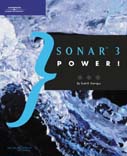SONAR 3 Power! tips from Scott Garrigus
Last updated on 3/28/2016

In the SONAR Power! series by Scott Garrigus, you will find helpful tips on an assortment of topics. We have collected a small sampling of tips from SONAR 3 Power! chapters 1-4 that will optimize your computer system's performance and maximize your productivity with SONAR.
Links to the latest versions of the SONAR Power! series and other SONAR related books can be found here.
SONAR 3 Power! tips from Scott Garrigus
Optimizing your PC performance by adjusting the latency settings
A good rule of thumb for setting the 'Latency' slider is this: If you are recording using input monitoring or playing DX instruments live via your MIDI keyboard, set your latency to a low value—maybe as low as two to four milliseconds when using WDM sound card drivers. If you are playing many audio tracks and using a lot of real-time effects while mixing down, set your latency to a higher value to relieve the strain on your computer system—maybe a value of around 20 milliseconds (or higher if needed) when you are using WDM sound card drivers.
Saving changes for the next session
Near the bottom of the 'Key Bindings' dialog box is the 'Save Changes for Next Session' option. When you select it, any key bindings you create will be saved so you can use them every time you run SONAR. If this option is not selected, you will lose any changes you've made when you exit the program. This option is selected by default. I suggest you keep it that way, unless for some reason you just need a few temporary key bindings during a recording session.
Safe saving
If you load a project in 'Safe Mode' with some or all of your plug-ins disabled, be careful when you save the project to disk. You should save the project using a different name so the original file remains intact. If you save the files using the same name, the original file will be overwritten and all your plug-in assignments will be lost.
The Patch Browser
You can also choose patches for a track using the Patch browser. Just right-click on the number of a MIDI track and choose 'Track Properties' to open the 'Track Properties' dialog box. Then click on the "Browse Patches' button to open the 'Patch Browser' dialog box. You will see a list of all the patches available from the instrument definitions you set up earlier. To search for a particular patch, type some text in the 'Show Patches Containing the Text' field. To choose a patch, select it from a list. Then click on OK.
Read part two of this series.
Read part three of this series.